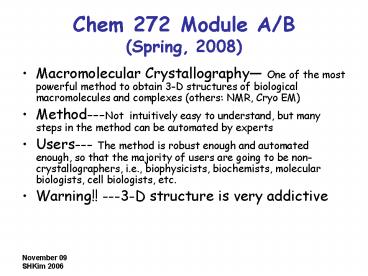November 09 - PowerPoint PPT Presentation
1 / 33
Title: November 09
1
Chem 272 Module A/B (Spring, 2008)
- Macromolecular Crystallography One of the most
powerful method to obtain 3-D structures of
biological macromolecules and complexes (others
NMR, Cryo EM) - Method---Not intuitively easy to understand, but
many steps in the method can be automated by
experts - Users--- The method is robust enough and
automated enough, so that the majority of users
are going to be non-crystallographers, i.e.,
biophysicists, biochemists, molecular biologists,
cell biologists, etc. - Warning!! ---3-D structure is very addictive
2
Topics
- Introduction of diffraction phenomena
- Demo Diffraction from 1D and 2D repeats of
simple objects - Demo Diffraction from complex objects
Convolution - Demo Diffraction from 3D repeat---e.g. helical
objects - "Reciprocal lattice"
- Ewald sphere
- Diffraction theoryMathematical approach
- Diffraction theory---Physical approach
- Experimentals---X-ray sources, crystallization,
etc. - Data Collection and Processing
- Substructure Determination
- Experimental Phasing
- Phasing by Molecular Replacement
- Phase Improvement
- Map Interpretation and Model Building
- Structure Refinement
- Twinning
- Automation
3
- Time Tue. and Thu. 200 330 PM
- Place Donner Laboratory (Rm 208)
- Text "Outline of Crystallography for
Biologists" - By David Blow (Oxford Univ. Press, 2003)
- Lecturers
- Sung-Hou Kim
- (SHKim_at_cchem.berkeley.edu 486-4333)
- Paul Adams
- (PDAdams_at_LBL.gov 486-4225)
- Exam A brief research proposal (5 pages) by 5/22
- 1. Title and abstract
- 2. Background and significance of questions
asked - 3. Research plan and feasibility
- 4. Possible outcome and interpretation
4
Lecture 1
- Introduction of diffraction phenomena
- Dimension of objects and the minimum
wavelength of radiation needed to observe the
objects - Imaging of an object
- Optical microscopy vs. Diffraction
- Demonstration of diffraction of an object by
laser - Relationship between object space and
diffraction space
5
(No Transcript)
6
Imaging of an object by lens Light can be bent
and focused by lens
7
Optical Microscopy
8
X-Ray Diffraction No X-ray lens
9
Dimensional Scaling
- Biological macromolecules
- Size of atoms 1 ? (0.1 nm)
- Need radiation of 0.1 nm wavelength, l
- He-Ne laser has l632.8 nm 0.6238 mm
- Need objects made of atoms of 0.6 mm
(6000X) or greater
10
Demonstration
- He-Ne laser (l632.8 nm) vs. X-ray (l0.1 nm)
- masks vs. atoms
11
(No Transcript)
12
Objects and Diffraction patterns (MolecularTran
sform)
13
Sampling of Molecular transform By Multiple
copies of an object
14
Reciprocal Relationship Size and Separation
15
Diffraction of Gases and Liquids
16
Conservation of Symmetry and Orientation
17
(No Transcript)
18
Demonstration
- One long thin slit
- ( One long thin molecule)
- One long thick slit
- ( One long fat molecule)
- Aligned multiple slits
- ( Parallel aligned long molecules)
19
Diffraction from One Slit
20
Diffraction from Many Slits
21
Fourier Transform
- Amplitude and phase of diffracted wave can be
described by mathematical operation of Fourier
transform - Diffraction intensity is proportional to the
square of diffraction amplidude
22
Diffraction from a slit (a long molecule)
23
(No Transcript)
24
(No Transcript)
25
(No Transcript)
26
Demonstration
- Two long thin slit
- ( One long thin molecule)
- Two long thick slit
- ( One long fat molecule)
- Aligned multiple two slits
- ( Parallel aligned long dimer molecules)
27
Diffraction Amplitude from One or Two Slits
28
Diffraction from Two Slits
29
(No Transcript)
30
Demonstration
- Diffraction from a single helical molecule
- Diffraction from multiple helical molecules
aligned in 1-D along helical axis - Intuitive interpretation of diffraction pattern
of helical molecules
31
(No Transcript)
32
(No Transcript)
33
Summary.
- Object size and the minimum wave length of
radiation to observe it - Microscopy and diffraction
- Monochromatic radiation and diffraction
- Object and diffraction pattern, Molecular
transform - Conservation of symmetry and orientation
- Reciprocal relationship of separation
- Each point of diffraction pattern comes from
whole object - Molecular transform and sampling































